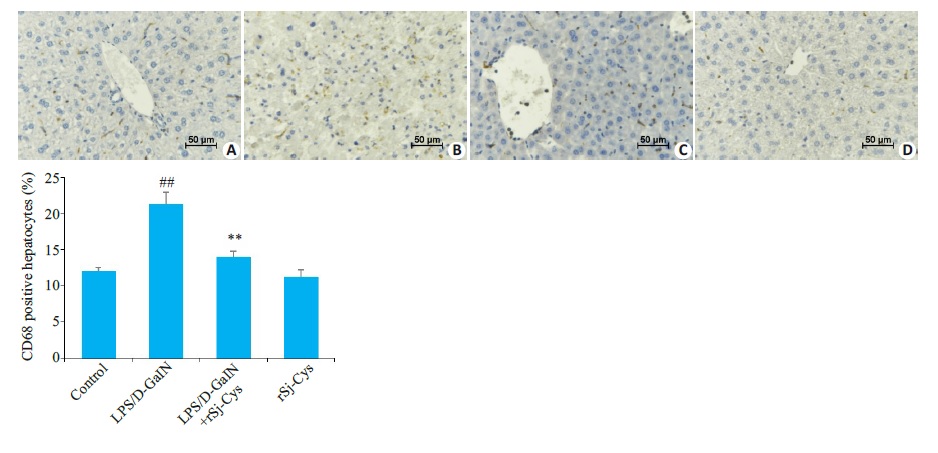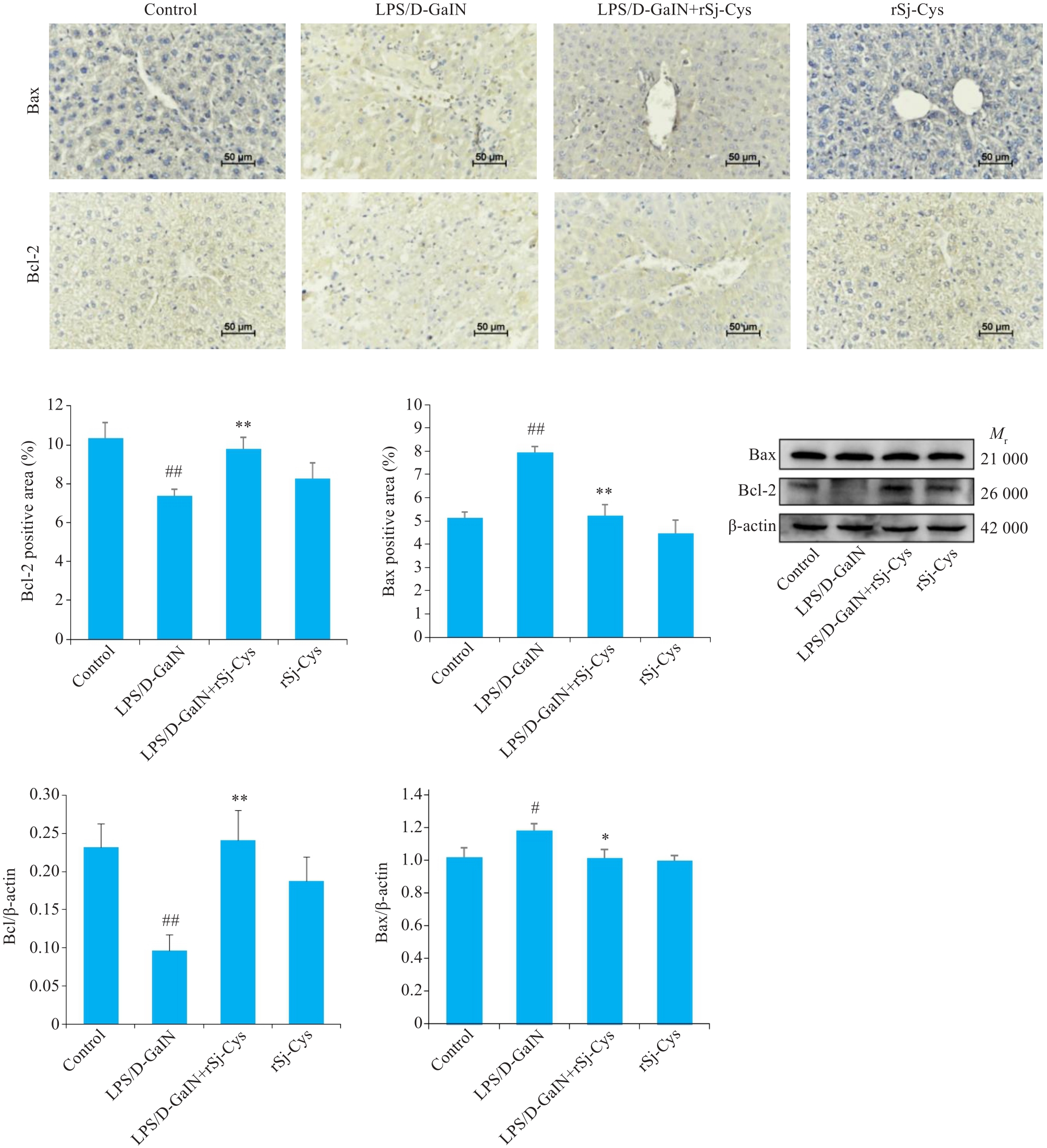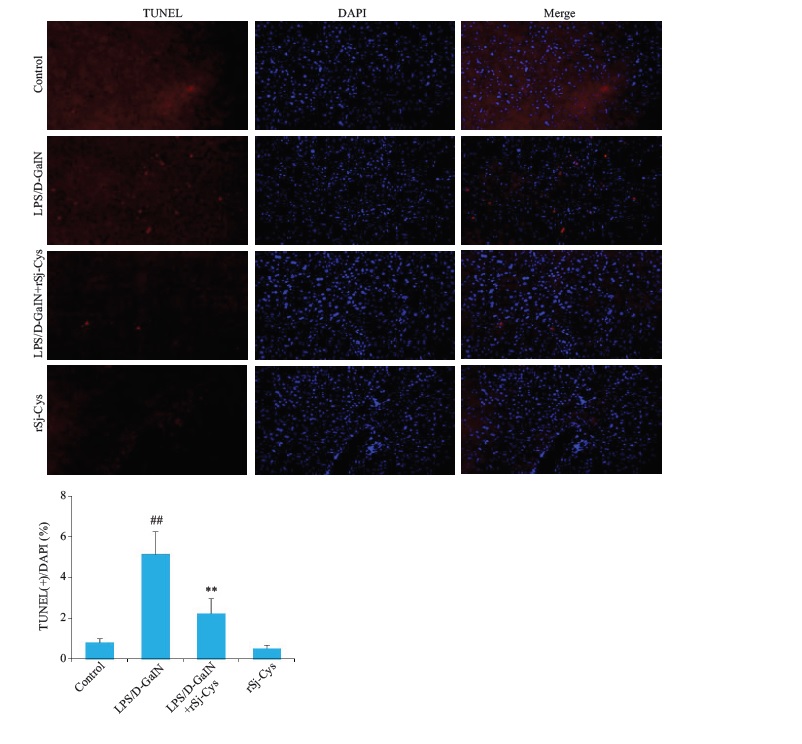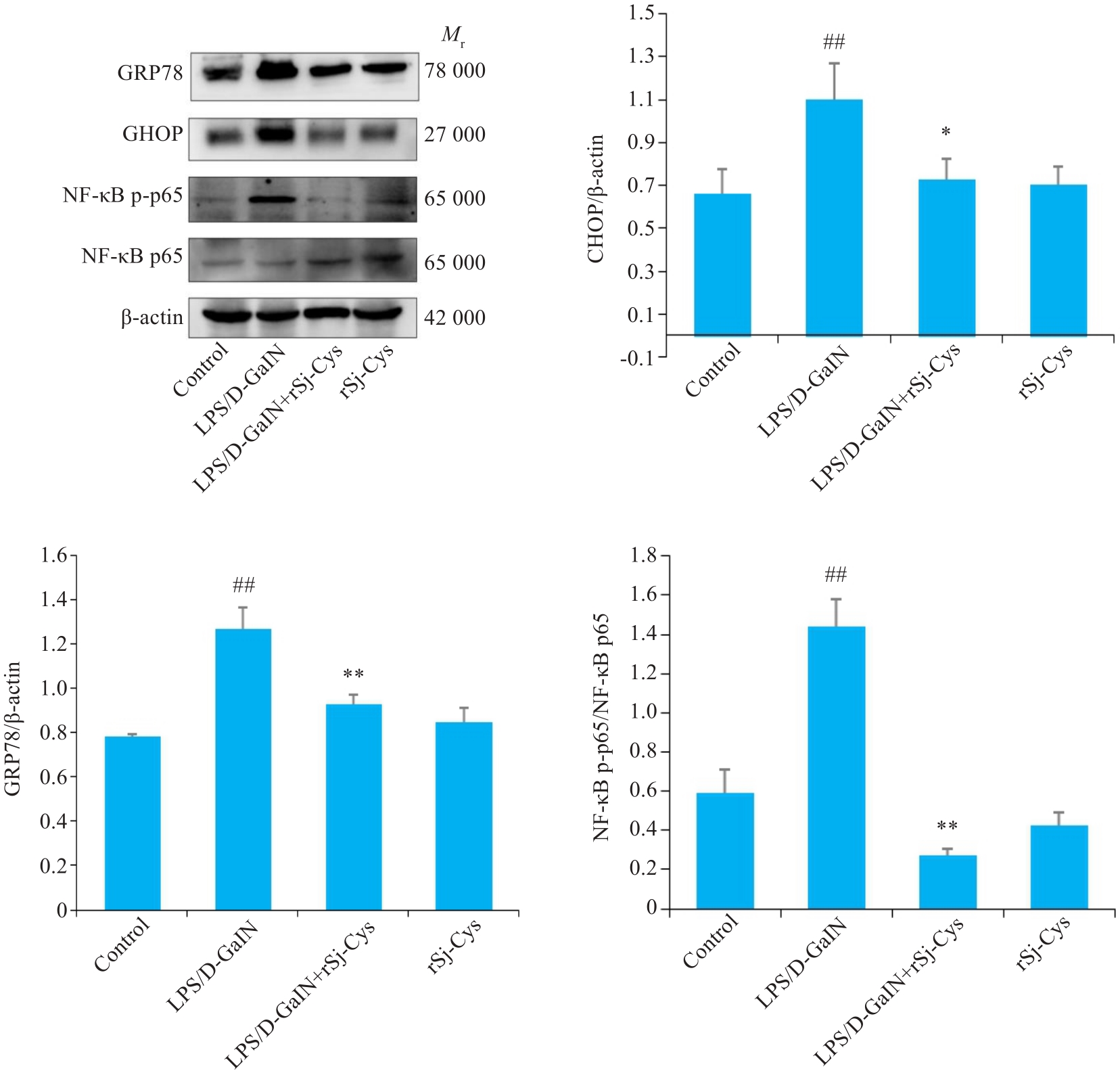Journal of Southern Medical University ›› 2024, Vol. 44 ›› Issue (6): 1126-1134.doi: 10.12122/j.issn.1673-4254.2024.06.13
Lingjun LU1( ), Xiaodi YANG2, Huaping ZHANG3, Yuan LIANG1, Xiulan SHI4, Xin ZHOU1(
), Xiaodi YANG2, Huaping ZHANG3, Yuan LIANG1, Xiulan SHI4, Xin ZHOU1( )
)
Received:2024-02-17
Online:2024-06-20
Published:2024-07-01
Contact:
Xin ZHOU
E-mail:lxx72308102@163.com;xinxin6633@yeah.net
Lingjun LU, Xiaodi YANG, Huaping ZHANG, Yuan LIANG, Xiulan SHI, Xin ZHOU. Recombinant Schistosoma japonicum cystatin alleviates acute liver injury in mice by inhibiting endoplasmic reticulum stress, inflammation and hepatocyte apoptosis[J]. Journal of Southern Medical University, 2024, 44(6): 1126-1134.
Add to citation manager EndNote|Ris|BibTeX
URL: https://www.j-smu.com/EN/10.12122/j.issn.1673-4254.2024.06.13

Fig.4 Pathological changes in the liver of the mice in different groups (HE staining, original magnification: ×200). A: Control group; B: LPS/D-GalN group; C: LPS/D-GalN+rSj-Cys group; D: rSj-Cys group.

Fig.5 Effect of rSj-Cys on CD68 expression in liver tissue of mice with acuteliver injury (Immunohistochemistry, ×400). A: Blank control group; B: LPS/DGalNgroup; C: LPS/D-GalN+rSj-Cys group; D: rSj-Cys control group; ##P<0.01 vs normal group; **P<0.01 vsLPS/D-GaIN group.

Fig.6 Effect of rSj-Cys on Bax and Bcl-2 expression in the liver tissue of mice with acute liver injury. #P<0.05 vs normal group; ##P<0.01 vs normal group; *P<0.05 vs normal group; **P<0.01 vs model group.

Fig.7 Effect of rSj-Cys on hepatocyte apoptosis in the livertissue of mice with acute liver injury detected by TUNELstaining (×200). Normal cell nuclei are stained blue andapoptotic cell nuclei are stained red. ##P<0.01 vs Controlgroup; **P<0.01 vs LPS/D-GaIN group.

Fig.8 Effect of rSj-Cys on expressions of endoplasmic reticulum stress-related signaling pathway proteins in mice with acute liver injury. ##P<0.01 vs Control group; *P<0.05 vs, **P<0.01 vs LPS/D-GaIN group.
| 1 | Yang WC, Wang YX, Zhang CG, et al. Maresin1 protect against ferroptosis-induced liver injury through ROS inhibition and Nrf2/HO-1/GPX4 activation[J]. Front Pharmacol, 2022, 13: 865689. |
| 2 | Lyu Z, Ji XF, Chen G, et al. Atractylodin ameliorates lipopolysaccharide and d-galactosamine-induced acute liver failure via the suppression of inflammation and oxidative stress[J]. Int Immunopharmacol, 2019, 72: 348-57. |
| 3 | Pang XH, Qiao Q, Vonglorkham S, et al. Asiatic acid ameliorates acute hepatic injury by reducing endoplasmic reticulum stress and triggering hepatocyte autophagy[J]. Biomedecine Pharmacother, 2020, 129: 110375. |
| 4 | Yang WC, Tao KX, Zhang P, et al. Maresin 1 protects against lipopolysaccharide/d-galactosamine-induced acute liver injury by inhibiting macrophage pyroptosis and inflammatory response[J]. Biochem Pharmacol, 2022, 195: 114863. |
| 5 | Hu XW, Li XM, Wang AM, et al. Caffeine alleviates acute liver injury by inducing the expression of NEDD4L and deceasing GRP78 level via ubiquitination[J]. Inflamm Res, 2022, 71(10/11): 1213-27. |
| 6 | Jiang ZQ, Ma YX, Li MH, et al. 5-Hydroxymethylfurfural protects against ER stress-induced apoptosis in GalN/TNF‑α‑injured L02 hepatocytes through regulating the PERK-eIF2α signaling pathway[J]. Chin J Nat Med, 2015, 13(12): 896-905. |
| 7 | Jiao ZH, Liu XN, Ma YJ, et al. Adipose-derived stem cells protect ischemia-reperfusion and partial hepatectomy by attenuating endoplasmic reticulum stress[J]. Front Cell Dev Biol, 2020, 8: 177. |
| 8 | Nan B, Yang CY, Li L, et al. Allicin alleviated acrylamide-induced NLRP3 inflammasome activation via oxidative stress and endoplasmic reticulum stress in Kupffer cells and SD rats liver[J]. Food Chem Toxicol, 2021, 148: 111937. |
| 9 | Chen ZY, Liu YL, Yang L, et al. MiR-149 attenuates endoplasmic reticulum stress-induced inflammation and apoptosis in nonalcoholic fatty liver disease by negatively targeting ATF6 pathway[J]. Immunol Lett, 2020, 222: 40-8. |
| 10 | 毕 晟, 丁有权, 齐建国. 蠕虫及蠕虫源性免疫调控性分子应用于自身免疫性疾病治疗的研究进展[J]. 细胞与分子免疫学杂志, 2016, 32(9): 1276-9, 1284. |
| 11 | Elliott DE, Weinstock JV. Helminth-host immunological interactions: prevention and control of immune-mediated diseases[J]. Ann N Y Acad Sci, 2012, 1247: 83-96. |
| 12 | Liu Y, Ye Q, Liu YL, et al. Schistosoma japonicum attenuates dextran sodium sulfate-induced colitis in mice via reduction of endoplasmic reticulum stress[J]. World J Gastroenterol, 2017, 23(31): 5700-12. |
| 13 | Xie H, Wu LQ, Chen XZ, et al. Schistosoma japonicum cystatin alleviates sepsis through activating regulatory macrophages[J]. Front Cell Infect Microbiol, 2021, 11: 617461. |
| 14 | Yang HJ, Li HQ, Chen WD, et al. Therapeutic effect of Schistosoma japonicum cystatin on atherosclerotic renal damage[J]. Front Cell Dev Biol, 2021, 9: 760980. |
| 15 | 褚 亮, 李徽徽, 王书书, 等. 源自日本血吸虫的半胱氨酸蛋白酶抑制剂对葡聚糖硫酸钠诱导的小鼠溃疡性结肠炎的影响[J]. 中国血吸虫病防治杂志, 2018, 30(3): 269-72, 338. |
| 16 | 林子扬, 林泉酉, 刁礼聪, 等. 复方贞术调脂胶囊通过TLR4/NF-κB通路改善脂多糖诱导的小鼠急性肝损伤[J]. 世界科学技术-中医药现代化, 2023, 25(1): 430-7. |
| 17 | 甘草酸制剂肝病临床应用专家委员会. 甘草酸制剂肝病临床应用专家共识[J]. 临床肝胆病杂志, 2016, 32(5): 844-52. DOI: 10.3969/j.issn.1001-5256.2016.05.004 |
| 18 | Wang HJ, Chen LY, Zhang XY, et al. Kaempferol protects mice from d-GalN/LPS-induced acute liver failure by regulating the ER stress-Grp78-CHOP signaling pathway[J]. Biomedecine Pharmacother, 2019, 111: 468-75. |
| 19 | 李燕楠, 杨小迪, 陈思宇, 等. 日本血吸虫重组半胱氨酸蛋白酶抑制剂对小鼠心肌梗死预后的影响及其免疫调节机制[J]. 中国生物制品学杂志, 2022, 35(1): 55-62. DOI: 10.3969/j.issn.1004-5503.2022.1.zgswzpxzz202201011 |
| 20 | 万勇坤, 李徽徽, 左 琳, 等. 日本血吸虫半胱氨酸蛋白酶抑制剂干预脂多糖诱导的小鼠脓毒症[J]. 南方医科大学学报, 2018, 38(5): 625-9. DOI: 10.3969/j.issn.1673-4254.2018.05.020 |
| 21 | Hu TY, Wang JY, Li WX, et al. Endoplasmic reticulum stress in hepatitis B virus and hepatitis C virus infection[J]. Viruses, 2022, 14(12): 2630. |
| 22 | Cao YP, He W, Li XP, et al. Rosiglitazone protects against acetaminophen-induced acute liver injury by inhibiting multiple endoplasmic reticulum stress pathways[J]. Biomed Res Int, 2022, 2022: 6098592. |
| 23 | Jiang CJ, Li JH. Research progress on mechanism of exercise improving non-alcoholic fatty liver disease through regulating endoplasmic reticulum stress[J]. Sheng Li Xue Bao, 2022, 74(5): 816-26. |
| 24 | Remick DG, Ward PA. Evaluation of endotoxin models for the study of sepsis[J]. Shock, 2005, 24(): 7-11. |
| 25 | Huang SJ, Xing YY, Liu Y. Emerging roles for the ER stress sensor IRE1α in metabolic regulation and disease[J]. J Biol Chem, 2019, 294(49): 18726-41. |
| 26 | Tam AB, Mercado EL, Hoffmann A, et al. ER stress activates NF-κB by integrating functions of basal IKK activity, IRE1 and PERK[J]. PLoS One, 2012, 7(10): e45078. |
| 27 | Li HH, Qiu DP, Yuan Y, et al. Trichinella spiralis cystatin alleviates polymicrobial sepsis through activating regulatory macrophages[J]. Int Immunopharmacol, 2022, 109: 108907. |
| 28 | 谢 红. 过继转移r-SjCystatin诱导的巨噬细胞对小鼠脓毒症的保护作用研究[D]. 蚌埠: 蚌埠医学院, 2020. |
| 29 | Wang YY, Zhou XQ, Zhao D, et al. Berberine inhibits free fatty acid and LPS-induced inflammation via modulating ER stress response in macrophages and hepatocytes[J]. PLoS One, 2020, 15(5): e0232630. |
| 30 | So JS. Roles of endoplasmic reticulum stress in immune responses[J]. Mol Cells, 2018, 41(8): 705-16. |
| 31 | 刘 娅. 日本血吸虫感染对DSS诱导实验性结肠炎的作用与机制研究[D]. 武汉: 武汉大学, 2017. |
| [1] | Guiling CHEN, Xiaofeng LIAO, Pengtao SUN, Huan CEN, Shengchun SHU, Bijing LI, Jinhua LI. Solasonine promotes apoptosis of non-small cell lung cancer cells by regulating the Bcl-2/Bax/caspase-3 pathway [J]. Journal of Southern Medical University, 2024, 44(6): 1109-1116. |
| [2] | Wei ZHOU, Jun NIE, Jia HU, Yizhi JIANG, Dafa ZHANG. Differential expressions of endoplasmic reticulum stress-associated genes in aortic dissection and their correlation with immune cell infiltration [J]. Journal of Southern Medical University, 2024, 44(5): 859-866. |
| [3] | HE Cheng, CHEN Wei, ZHANG Nianzhi, LUAN Jun, WANG Sanfeng, ZHANG You. Shenqi Chongcao Formula ameliorates inflammatory response in rats with pulmonary fibrosis by activating the ASS1/src/STAT3 signaling pathway [J]. Journal of Southern Medical University, 2024, 44(4): 644-651. |
| [4] | BAO Hansheng, WANG Sutong, LÜ Mujie, WANG Yongcheng, JIANG Ping, LI Xiao. Activation of α7 nAChR improves white fat homeostasis and promotes beige adipogenesis and thermogenesis in obese mice [J]. Journal of Southern Medical University, 2024, 44(3): 499-506. |
| [5] | ZHANG Xiaoyan, WANG Xie, WANG Jie, SHAO Nan, CAI Biao, XIE Daojun. Huangpu Tongqiao Capsule improves cognitive impairment in rats with Wilson disease by inhibiting endoplasmic reticulum stress-mediated apoptosis pathway [J]. Journal of Southern Medical University, 2024, 44(3): 447-454. |
| [6] | CHEN Guodong, LUO Suxin. Colchicine alleviates myocardial ischemia-reperfusion injury in mice by activating AMPK [J]. Journal of Southern Medical University, 2024, 44(2): 226-235. |
| [7] | WU Guangyang, SONG Tianli, TANG Lang, WANG Yiming, LIU Xu, HUANG Sheng. Total saponins of Panax japonicus alleviates CCl4-induced acute liver injury in rats by regulating the PI3K/AktNF-κB signaling pathway [J]. Journal of Southern Medical University, 2024, 44(2): 244-251. |
| [8] | DUAN Ting, ZHANG Zhen, SHI Jinran, XIAO Linyu, YANG Jingjing, YIN Lixia, ZHANG Xiaofeng, GENG Zhijun, LU Guoyu. High expression of CPNE3 correlates with poor long-term prognosis of gastric cancer by inhibiting cell apoptosis via activating PI3K/AKT signaling [J]. Journal of Southern Medical University, 2024, 44(1): 129-137. |
| [9] | LIU Xuerou, YANG Yumei, CAI Hui, ZHANG Yaoshuai, FAN Fangtian, LI Xian, LI Shanshan. Aumolertinib inhibits proliferation, invasion and migration and promotes apoptosis of neuroblastoma cells by downregulating MMP2 and MMP9 expression [J]. Journal of Southern Medical University, 2023, 43(9): 1493-1499. |
| [10] | LAN Yu, WANG Kaifeng, LAN Zhixian, ZHOU Heqi, SUN Jian. Dealcoholized red wine inhibits occurrence and progression of hepatocellular carcinoma possibly by inducing cell cycle arrest and apoptosis [J]. Journal of Southern Medical University, 2023, 43(8): 1297-1305. |
| [11] | YE Jingjing, XU Wenqin, XI Bangsheng, WANG Nengqian, CHEN Tianbing. Lactate-induced up-regulation of PLEKHA4 promotes proliferation and apoptosis of human glioma cells [J]. Journal of Southern Medical University, 2023, 43(7): 1071-1080. |
| [12] | SHAO Rongrong, YANG Zi, ZHANG Wenjing, ZHANG Nuo, ZHAO Yajing, ZHANG Xiaofeng, ZUO Lugen, GE Sitang. Pachymic acid protects against Crohn's disease-like intestinal barrier injury and colitis in mice by suppressing intestinal epithelial cell apoptosisviainhibiting PI3K/AKT signaling [J]. Journal of Southern Medical University, 2023, 43(6): 935-942. |
| [13] | ZHENG Qingwei, SHAO Yidan, ZHENG Wanting, ZOU Yingxue. Cordycepin, a metabolite of Cordyceps militaris, inhibits xenograft tumor growth of tongue squamous cell carcinoma in nude mice [J]. Journal of Southern Medical University, 2023, 43(6): 873-878. |
| [14] | SHI Wenhui, LIU Xiaolian, ZHANG Guiming, YE Linxuan, ZHOU Runhua, LI Yilei, YU Le. RITA selectively inhibits proliferation of BAP1-deficient cutaneous melanoma cells in vitro [J]. Journal of Southern Medical University, 2023, 43(5): 710-717. |
| [15] | LIU Fang, PENG Lanzhu, XI Jingle. High expression of MYH9 inhibits apoptosis of non-small cell lung cancer cells through activating the AKT/c-Myc pathway [J]. Journal of Southern Medical University, 2023, 43(4): 527-536. |
| Viewed | ||||||
|
Full text |
|
|||||
|
Abstract |
|
|||||